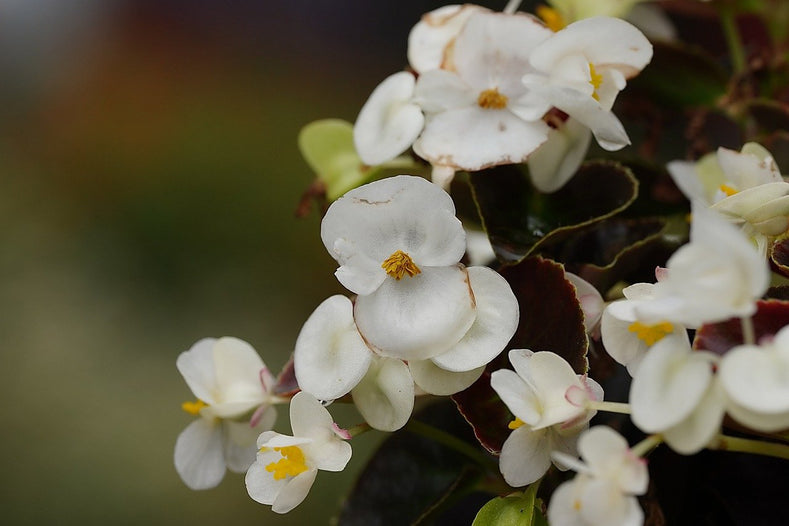How And When To Plant Begonia Tubers?
Begonia plants are loved for their showy flowers, shapes, and sizes. They are often used as bedding plants or in pots and hanging baskets. They brighten up partial shade gardens, patios, and indoor spaces. Planting tuberous Begonias at the right time is key to enjoying a lush display of flowers throughout the summer. In this guide, we’ll discuss when to plant tuberous Begonias and give helpful tips about caring for these stunning flowers.
When To Plant Begonia Tubers?
The best time to plant Begonias is in spring, as tuberous Begonias bloom throughout the summer. The risk of frost is usually lower at this time. Plant the tubers when the last frost has disappeared, and temperatures are above 50ºF (10°C). Begonias are very sensitive to frost, and cold and wet conditions in early spring, so it’s best to wait until it gets warmer.
Read more: All About Begonias
How To Plant Begonia Tubers?
Arriving
When you order your favorite Begonia tubers from DutchGrown, you will receive a parcel with your summer flowering tubers in the spring. We start shipping to the US in mid-March.
Time
Wait until the last frost has passed with temperatures above 50ºF (10°C). In colder climates, you can start planting Begonias indoors if you plan to plant them in the garden.
Location
Begonias are tropical plants and are native to these climates. The plant prefers bright, indirect light without the harshness of direct afternoon sun. The best location is a spot that receives morning sunlight and afternoon shade.
Soil
Plant a tuberous Begonia in rich, well-drained soil. Add compost or peat moss to the soil to improve fertility and drainage. Do you want to plant in pots? Use a high-quality potting mix that allows good drainage, and make sure the pot has drainage holes.
Planting And Sprouting
-
Plant tubers in cold climates: Place the tubers, hollow side up, 1 inch (2.5 cm) apart, in a shallow tray filled with moist potting mix. Cover with soil. Keep the tray in a warm room with indirect light and damp (not wet) soil. Keep the tubers indoors until frost has passed.
-
Plant tubers in warm climates: Wait until the frost has gone and plant the tubers directly outside. Plant them about 1 inch (2.5 cm) deep, with the hollow (concave) side facing up.
Potting
Within 4 weeks, the tubers should start to sprout. It’s time to transplant them to containers (indoors if there is still frost) or your garden.
-
Container: Fill your pots with potting mix, leaving a little space at the top. Plant the Begonias so that the top of the root ball is just below the edge of the pot. Water thoroughly.
-
Garden: Dig holes that are as deep and twice as wide as the root balls of your Begonias. Space the plants or tubers about 6-12 inches (15–30 cm) apart, depending on the variety. Cover the roots with soil and press down gently. Water your Begonias to settle the surrounding soil.
Growing Tuberous Begonias
Once you have planted your Begonia tubers, you, of course, want to know how to get the best out of them. Watering, fertilizing and deadheading are the basics. Follow the instructions below for the best results.
Water
Water moderately every few days to keep the soil moist but not soggy. Be careful not to over-water, as the tubers are susceptible to rot in wet conditions, and the stems of potted plants can rot. You can reduce watering towards the end of the season.
Fertilizer And Mulch
Use a balanced, water-soluble fertilizer every few weeks during the growing season to encourage growth and flowering. Apply a thin layer of mulch around outdoor Begonias to help retain soil moisture and keep the roots cool. Pot-grown Begonias do not require mulch.
Deadheading
Deadhead throughout the season to keep Begonias looking their best. Cut off spent or rotting flowers about an inch below the flower to prevent infection and keep the plant healthy.
Learn more: How to Grow Begonias
What To Do With Begonia Tubers After Flowering?
Begonias are sensitive to frost, and cold and wet conditions. So it’s best to dig up the tubers before it gets too cold outside.
Store
Allow the flowers to die back naturally and wait for the (deep) green foliage to turn yellow. Shake off the soil, clean off any remaining dirt, and dry the tubers in a sunny place for a week. Store them individually in paper bags or wrapped in newspaper.
Check Out A Wide Range Of Begonia Tubers At DutchGrown
Planting a tuberous Begonia at the right time and in the right conditions can transform your garden or containers into a vibrant display with colorful blooms. At DutchGrown, you can find a collection of top-sized Begonia tubers that will turn into beautiful flowers. From the red-colored Begonia Marmorata to the Begonia Wummi Apfelblüte with gentle shades of soft pink and blush. Discover the collection now. We ship from Holland to all over the US.

